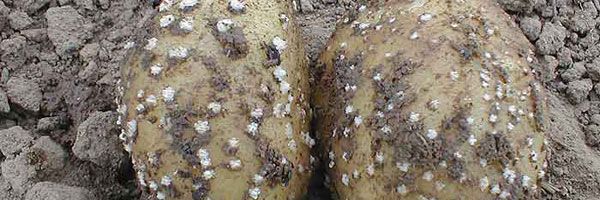
Enlarged lenticels
- Symptoms
The enlarged lenticels are formed when the tubers spend a long time in the soil in wet conditions. Initially they consist of numerous whitish outgrowths (“cauliflower” lenticels on the surface of the tuber) (photo 1) which dry and then suberise to form brown dots measuring 1 to 3 mm (photo 2). These are usually distributed all over the surface of the tuber.
- Risk factors
Lenticels are specialised, barely visible, skin organs which ensure communication between the outside and the inside of the tuber and play an essential role in respiration. They are protected from the outside by non-suberized cells formed by a special meristem. If the soil is very moist, an abnormal quantity of these cells is formed, giving whitish outgrowths on the surface of the tuber (“cauliflower” lenticels, photo 1).
The lenticels are then wide open. When the soil becomes less moist and the tubers dry, these accumulations also dry, leaving a suberized scar of variable size around the lenticel (photos 2 to 4).
The presence of enlarged lenticels on tubers may have important economic consequences once tubers are washed for the fresh market and are particularly visible on red skin cultivars.
Moreover, enlarged lenticels provide, in the field, entry points for various fungi (Fusarium spp., Phoma spp., Pythium spp.), soft rot bacteria (Pectobacterium spp.), and even common scab (Streptomyces scabies and spp.) (photo 5).
- Control
When there is heavy rainfall, storms in particular, this disorder is hard to avoid completely, especially in a badly drained plot. It is important therefore to:
- irrigate regularly but not excessively;
- ensure a good soil structure and efficient drainage;
- wait for the lenticels to reduce in size before haulm destruction;
- dry the tubers thoroughly at harvest time.





